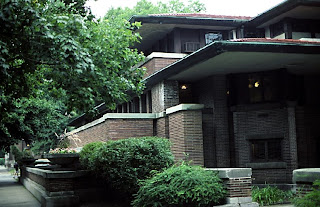I realize that this is old news, but I wanted to do a blog on the architecture mentioned in the book, specifically that of Frank Lloyd Wright. As I read the book, I find very little that pops out at me and interests me to do further reading. All of the abstract work doesn’t sit well with me so I really enjoyed reading about some architecture. Any architecture interests me, but when it comes to Frank Lloyd Wright, I am more than interested. His work simply amazes me. As I look at Fallingwater, I am intrigued by the beauty of the architecture and his brilliant work with integrating the building into the natural landscape. Then as I read more about it I become even more in awe of his talents. His attention to detail that isn’t even noticed from the outside viewer is fantastic. The simple fact that from nowhere in the house can you see the waterfall seems kind of overkill and unnecessary, but it is something he felt was important to do so he spent time and effort and did it.
His other works don’t please the eyes as much as Fallingwater, yet they are still architectural masterpieces. The other work of his mentioned in the book is the Robie house in Chicago. While it doesn’t include a waterfall in the middle of the house, it is still gorgeous and really shows where he got his inspiration, from Asian architecture. Asian architecture likes to use the principle of horizontality, by which the building might hug the earth. Using that principle, Wright designed such houses as the Robie house. Take a look at these pictures. While the Robie house may seem toned down a bit, it is obvious to see where Wright got his inspiration and he mimicked the Asian architectural beauty very well.



No comments:
Post a Comment